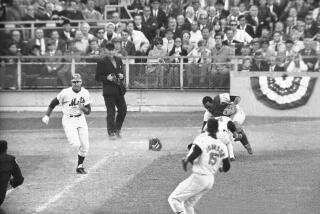USGA, R&A; Change Driver ‘Spring’ Rule
- Share via
The long and often bitter debate about setting technological limits on golf clubs took an unexpected turn Tuesday when the game’s ruling bodies reversed their positions and scaled back what they previously had decided to allow.
The U.S. Golf Assn. and the Royal and Ancient announced an agreement to set the coefficient of restitution (COR)--the measure of the springlike effect of golf balls struck by drivers--at .830 beginning in 2003 in the United States and at the British Open.
When the USGA and the R&A; announced a joint proposal May 9 to set COR limits on the advanced drivers, a higher .860 COR standard was established for amateur golfers, with the .830 limit applying to “highly skilled golfers,” or the professionals. Under the proposal, the higher COR standard for amateurs would have been in force until 2008, when the COR limit would have been lowered to .830.
Golf club manufacturing heavyweights Callaway Golf and TaylorMade heralded the plan at the time because they would be permitted to market and sell drivers conforming to the official, higher limits until 2008. Three months later, the clubmakers found that permission rescinded.
According to the USGA, the decision to set the lower limit of .830 and abandon the May 9 proposal of .860 was made in order to placate the clubmakers.
“It was simply that people, manufacturers ... thought that going up and back down was too disruptive in the marketplace,” said Reed MacKenzie, president of the USGA.
However, a spokesman for Callaway Golf took issue with such a rationale.
“Anybody who says it was done for the benefit of the manufacturers obviously didn’t talk to anybody at the largest golf club manufacturer in the world,” said Larry Dorman, a vice president at Callaway.
Chip Brewer, chief executive officer of Adams Golf, was similarly perplexed.
“Clearly, we were surprised by the USGA’s announcement,” he said. “Does the golfer win? I don’t know the answer. Does the industry win? I think the answer is probably no, but I also do not believe protecting the industry is the USGA’s job.”
A spokesman at TaylorMade Golf says the company will have no comment until Friday.
Ron Drapeau, Callaway’s president and chief executive officer, called the USGA’s moves “rigid” and “arbitrary.”
The .830 COR limit on driving clubs affects amateurs who post scores for handicap purposes.
Also, the R&A; will not institute the .830 limit until 2008, although “highly skilled players” must adhere to the limit in 2003, which affects the British Open.
The debate over the thin-faced drivers has raged since 1998, when the USGA imposed its .830 limit while the R&A; set no limit on the springlike effect of the clubs.
The USGA is the governing body for golf in the U.S., Canada and parts of South America; the R&A; sets the standards for the rest of the world.
More to Read
Go beyond the scoreboard
Get the latest on L.A.'s teams in the daily Sports Report newsletter.
You may occasionally receive promotional content from the Los Angeles Times.










